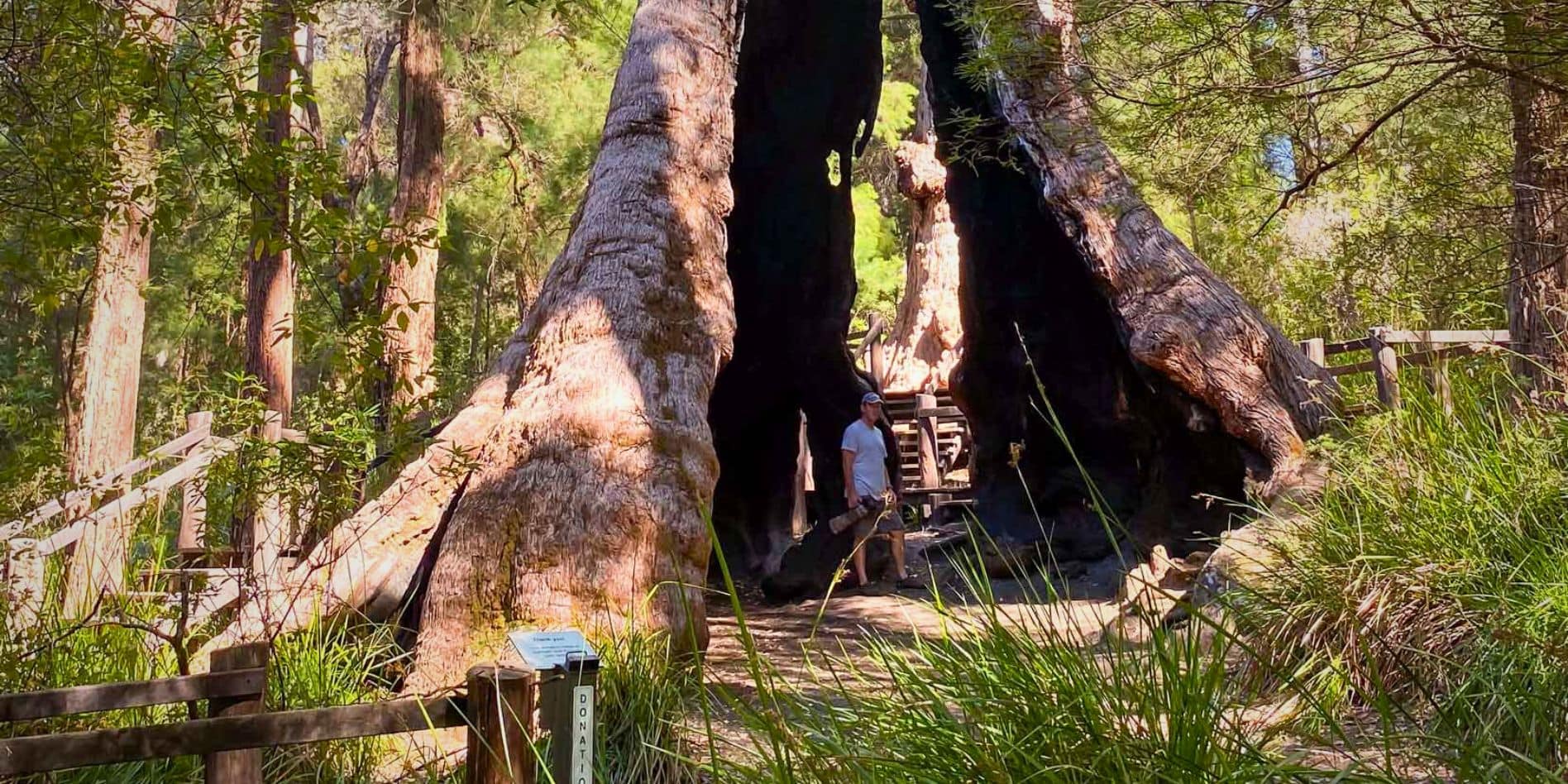When Lars and I visited the Giant Tingle Tree in Walpole the day after our trip to the Valley of the Giants Tree Top Walk, an adventure I’ve enjoyed several times when the kids were younger.
Yet, this was our inaugural visit to the Giant Tingle Tree, a five-minute drive from Walpole. Honestly, I was unaware of its existence, having assumed the most colossal tingles were nestled within the Valley of the Giants.
And there it stood.
Having experienced its sheer size and contemplated its 300-year legacy firsthand, attempting to frame its grandeur in a photograph was nothing short of awe-inspiring.
The air, rich with the scent of ancient bark and resonating with birdcalls, made our visit unforgettable. It’s an experience that truly comes to life when you’re there in person.
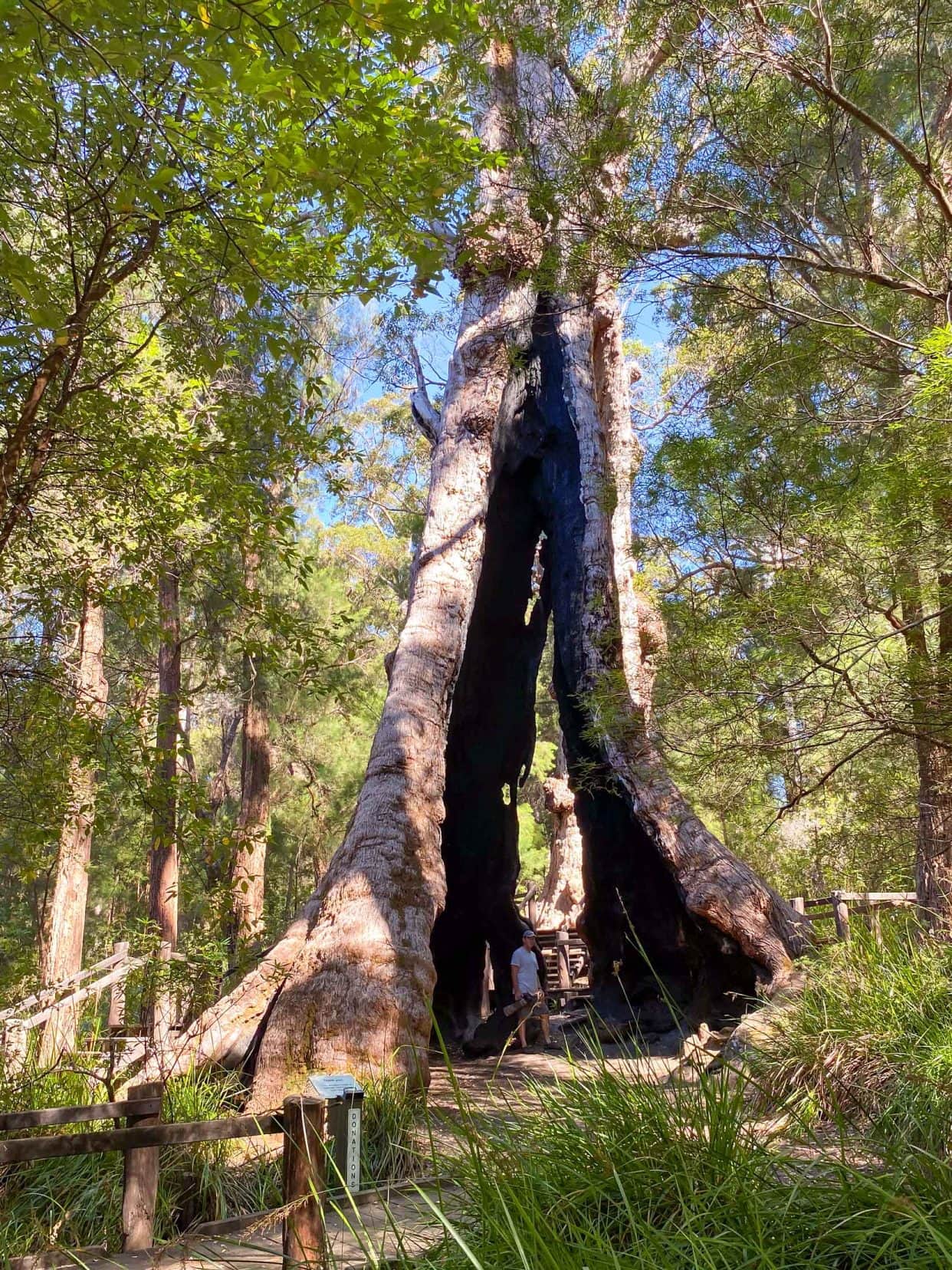
Despite the awe-inspiring sight of this colossal tree, our visit faced challenges. A swarm of March flies hindered our photography and enjoyment of the forest. We’re planning a spring return, aiming for a more leisurely exploration and photography session without the nuisances.
Visiting the Tree Top Walk before encountering the giant tingle tree enriched our appreciation for the ecosystem sustaining this magnificent specimen.
Why read on?
The reason is straightforward. Our adventures in Western Australia are brimming with practical advice and genuine travel recommendations. Our guide is crafted to enhance your journey, ensuring it’s seamless and memorable.
Join us as we delve into Walpole’s ancient forests, drawing you closer to the marvels of the Giant Tingle Tree.
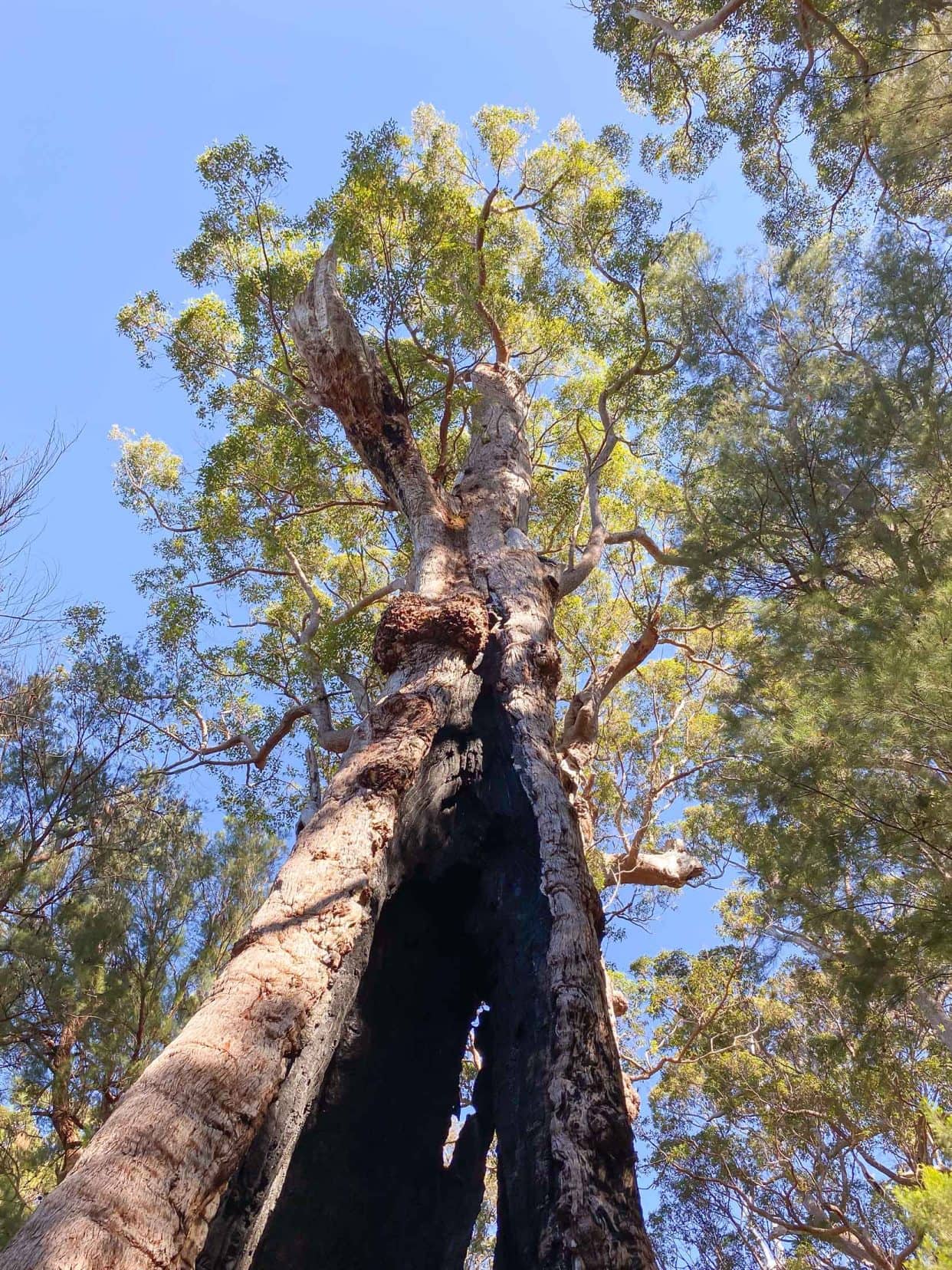
Giant Tingle Tree Walpole: Quick Guide
- Location 📍: Walpole-Nornalup National Park, WA.
- Tree Facts 🌳: It is over 300 years old, 75m tall, and has a base circumference of 24m. It is the largest living red tingle tree in the world.
- Unique Quality 🔍: Only found in Western Australia, the red tingle trees are known for their massive girth and longevity, living up to 400 years.
- Getting There 🚗: It’s a 5-minute drive from Walpole, then a short walk. Follow South Coast Highway and turn left onto Hilltop Road. Signage is available.
- Viewpoint on the Way 🌄: Hilltop Lookout offers stunning views of Nornalup Inlet and the Southern Ocean.
- Walk Details 🚶♂️: This is a 1 km circular walk around the tree, with a protective boardwalk around it. You’ll have intimate views inside the tree’s hollow base.
- Photography Tips 📸: The best light is in the early morning or late afternoon. Use a wide-angle lens for full shots and a macro lens for detailed textures.
- Visit Duration ⏰: Around 30 minutes, longer without flies.
- Facilities 🚻: Car park, toilets, picnic area, and information pavilion at the start of the walk.
- Cost 💰: Free entrance to the park and walk.
- Accommodation 🛏️: Coalmine Beach Caravan Park offers camping, chalets, and luxury tents.
- Conservation Tip ♻️: Stay on paths to protect the tree’s root system. Use toilets near the carpark.
- Best Time to Visit 🌸: Pleasant in spring (September/October) for wildflower viewing. Avoid public and school holidays to miss crowds.
Note: The Valley of the Giants Tree Top Walk nearby offers a broader perspective on the ancient forest and is worth visiting first to learn about the tingle trees.
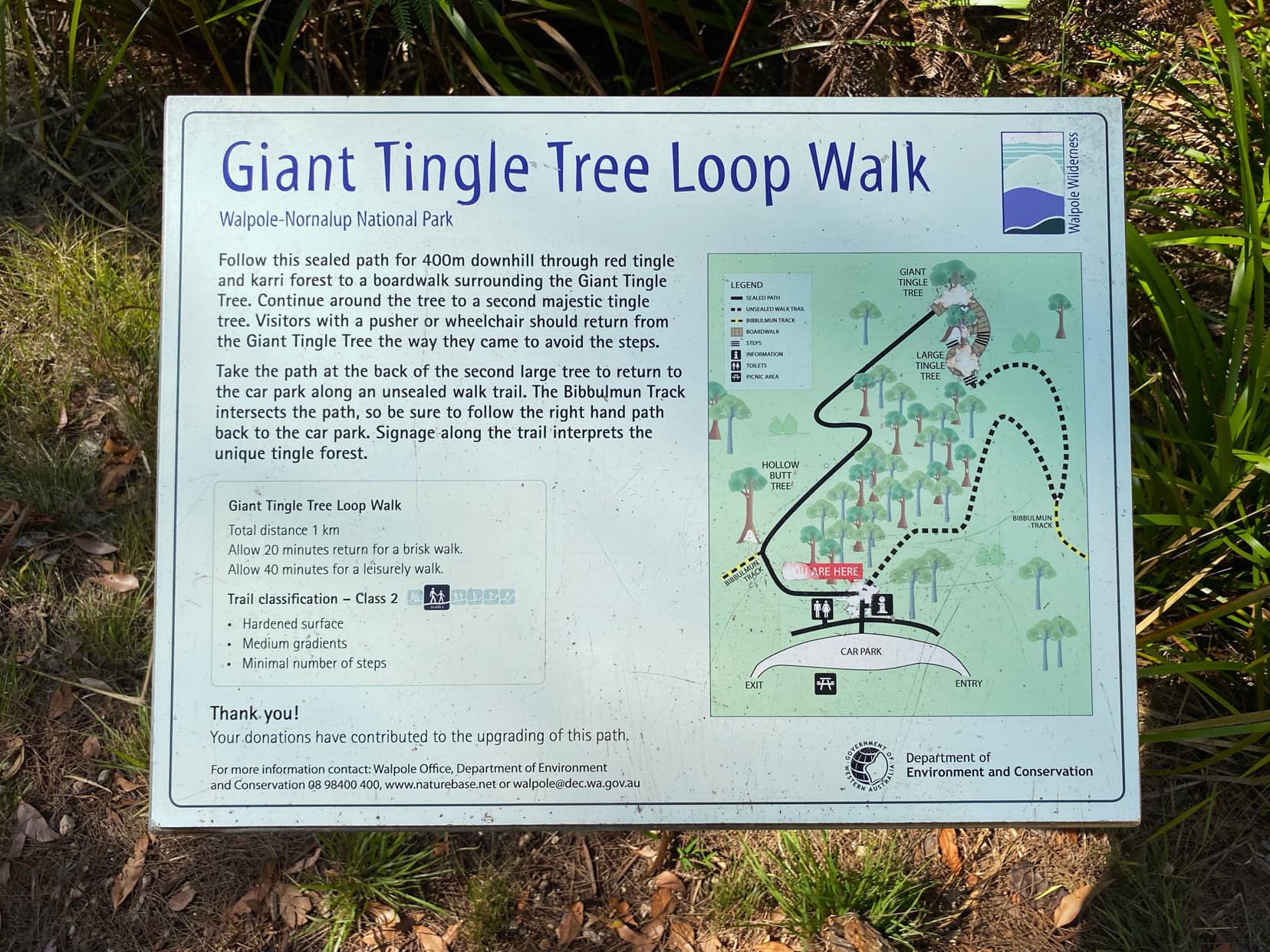
A Video Tour: The Giant Tingle Tree and Surrounds
Dive into our video journey through the roads leading to the Giant Tingle Tree in Walpole. From the drive through the ancient forest, capturing the area’s essence, to the panoramic view at Hilltop Lookout and the walk along the boardwalk.
About The Giant Tingle Tree Walpole
Nestled in the heart of the Walpole Wilderness, the Giant Red Tingle Tree stands as a testament to nature’s grandeur.
This colossal tree, the world’s largest living tingle, boasts a base circumference of 24 meters and reaches 75 meters skyward. With an age surpassing 300 years, its presence is a living history of the Australian bush.
Fire, a natural sculptor within this landscape, has hollowed out the Giant Tingle, yet it stands resilient. Its remarkable buttress root system and expansive base trunk are evolutionary adaptations, allowing it to thrive despite its hollow core.
The tingle family comprises three distinct species within the Walpole region:
- Red Tingle (eucalyptus jacksonii), known for its massive girth
- Yellow Tingle (eucalyptus guilfoylei)
- Rate’s Tingle (eucalyptus brevistylis)
The yellow and Rates tingles are both smaller than their red counterpart.
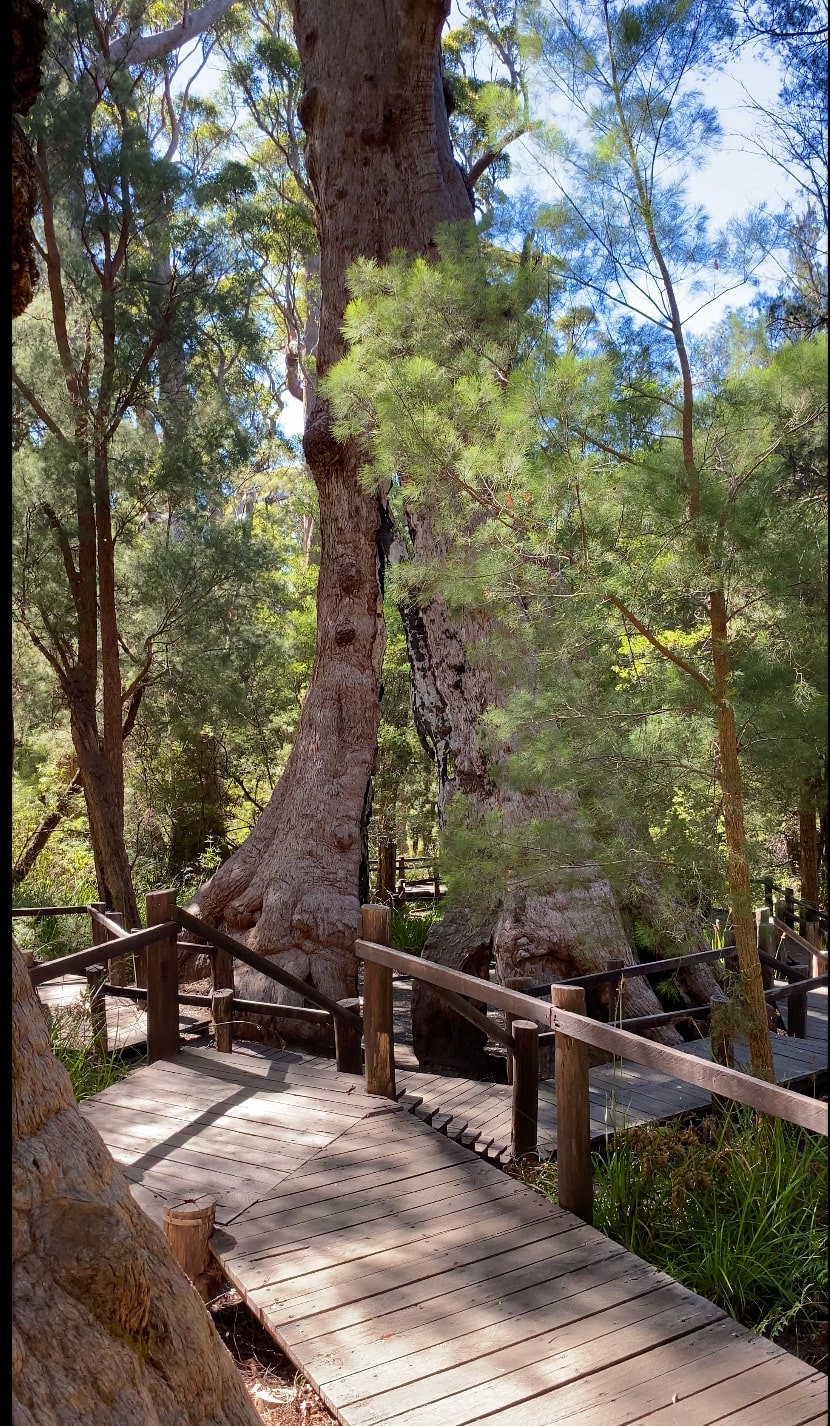
Where are Tingle Trees Found?
These ancient giants, capable of living up to 400 years, are exclusively found in the southern reaches of Western Australia, specifically in the Walpole area.
They stand majestically among a venerable assembly of karri, jarrah, and marri trees, marking the landscape with their imposing stature.
This unique congregation of trees is safeguarded within the expansive Walpole Wilderness area, a mosaic of ten National Parks that includes the Walpole-Nornalup National Park and the Walpole-Nornalup Inlets Marine Park.
Preserving these giants within the Walpole Wilderness highlights the region’s ecological importance. It underscores the commitment to safeguarding these natural wonders for future generations to marvel at and learn from.
Giant Tingle Tree Map: Navigating Your Visit
Giant Tingle Tree Map
Where is the Giant Tingle Tree?
The Giant Tingle Tree, a marvel of nature, is nestled within the Walpole-Nornalup National Park, and a five-minute drive from the town of Walpole.
Leaving Walpole, head southeast on the South Coast Highway before turning left onto Hilltop Road, a one-way gravel path leading directly to this ancient giant.
The route is well-marked, ensuring easy navigation through the ancient forest, with the imposing dead straight karri trees, red tingles and she-oaks lining the way.
A Serendipitous Discovery: Hilltop Lookout
En route to the Giant Tingle, a delightful viewpoint presents itself—Hilltop Lookout.
Unbeknownst to us on our journey, this vantage point offered a spectacular panoramic view that stretched across Nornalup Inlet to the vast expanse of the Southern Ocean.
It’s a spot to be noticed, perfect for capturing the essence of the region’s natural beauty in a single frame.
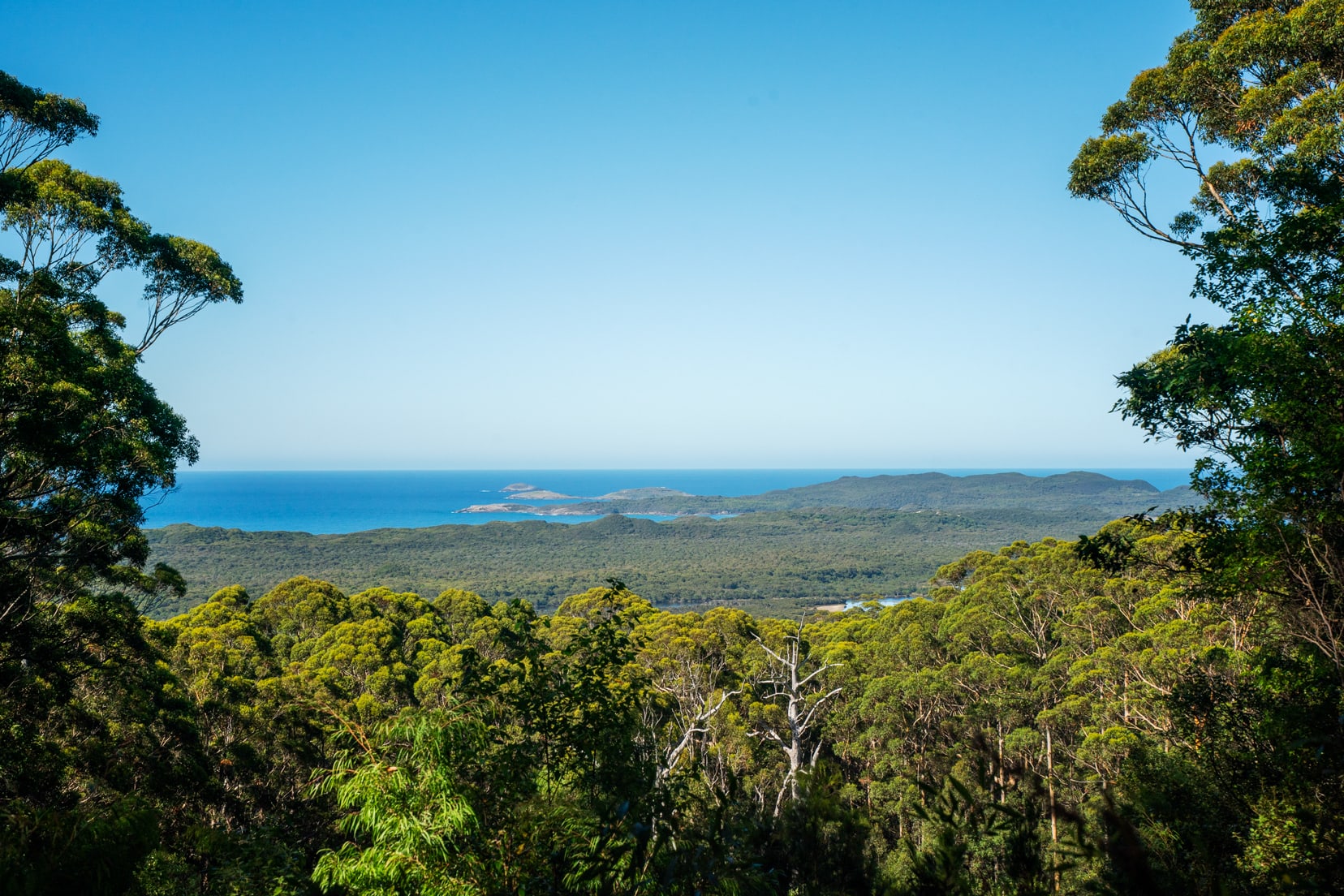
Embarking on Foot: Trails from Hilltop Lookout
1. Hilltop Lookout to the Giant Tingle Tree
For those inclined to merge their visit with the tranquillity of nature, a walking option enriches the adventure.
This short section of the Bibbulmun Track offers a 5 km return trail from Hilltop Lookout to the Giant Tingle Tree.
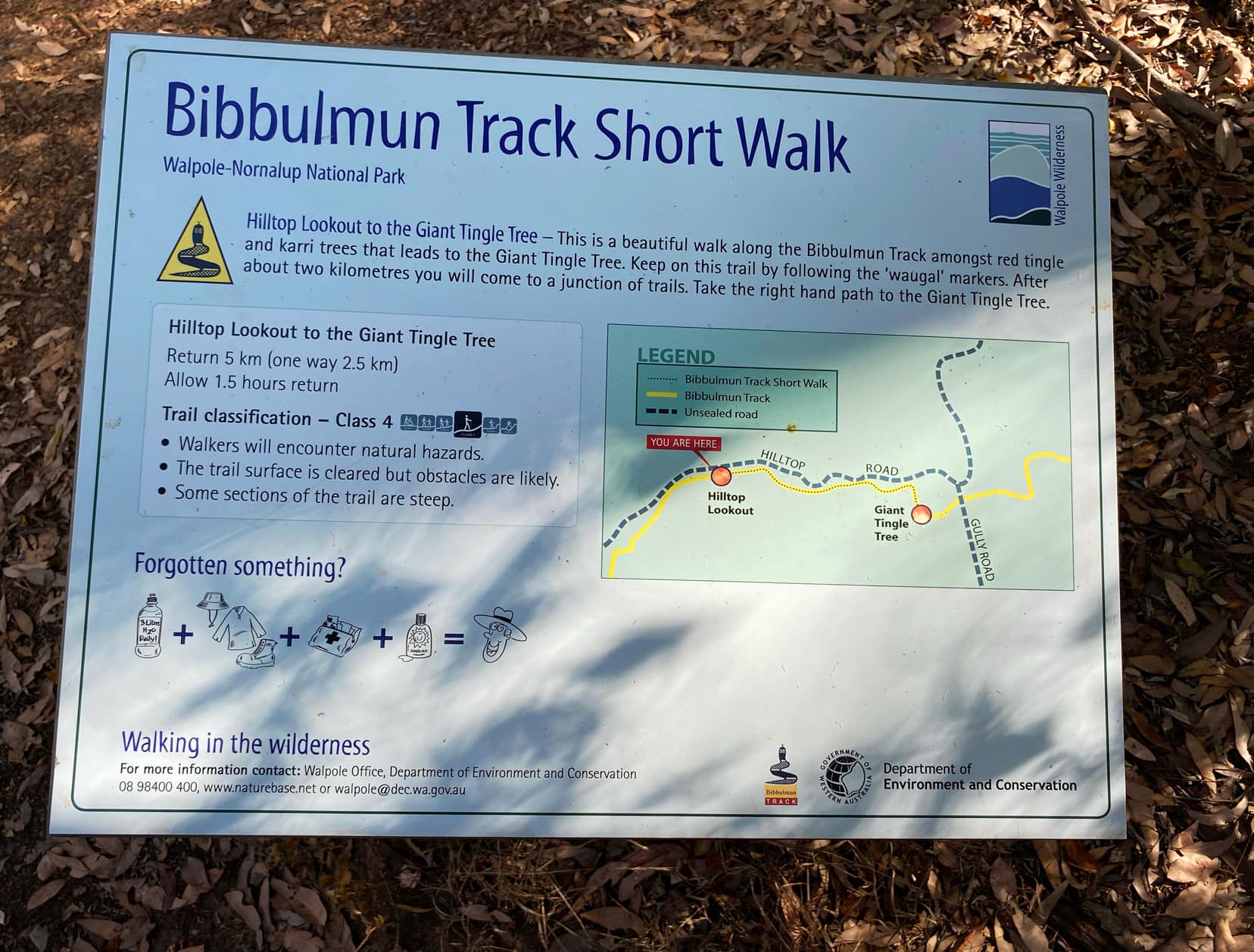
2. Delaney Walk
Alternatively, the Delaney Walk proposes a more challenging journey from Hilltop Lookout to Coalmine Beach on Nornalup Inlet.
This moderate to strenuous hike of 10 km return weaves through diverse landscapes.
Practical Notes
- Caravan Access: The gravel road to the Giant Tingle Tree is unsuitable for caravans, so visitors plan accordingly.
- Travel Time: The journey from Perth to Walpole takes roughly 5 hours, but it’s worth it for Western Australia’s southwest’s stunning beauty and tranquillity.
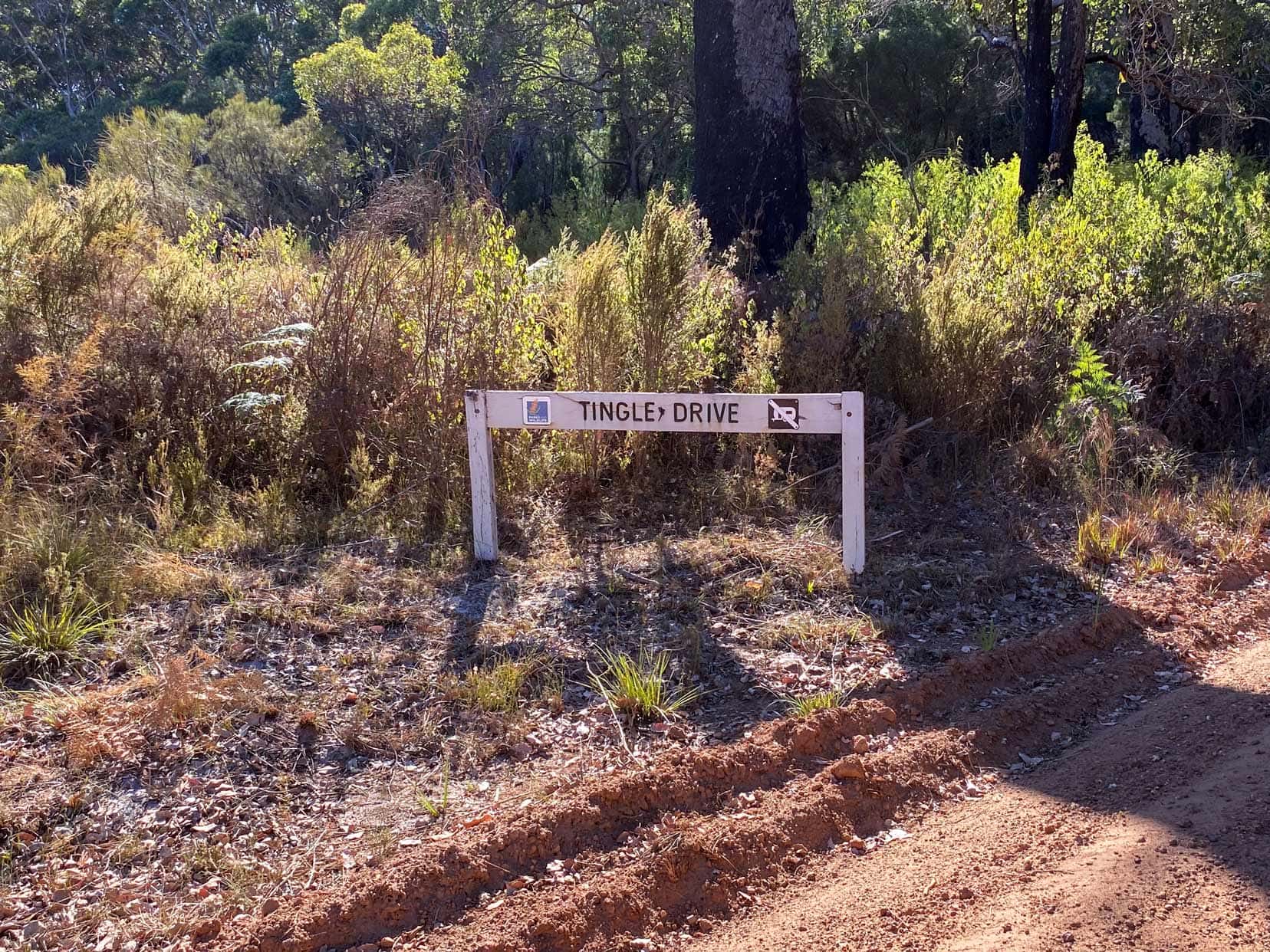
About The Giant Tingle Tree Loop, Walpole-Nornalup National Park
Set within Walpole-Nornalup National Park, the Giant Tingle Tree beckons through a 1 km circular walk, blending the wonders of nature with educational insights:
- Facilities: Equipped with a car park, toilets, picnic area, and an information gazebo for convenience.
- Trail Details: The loop features a path and boardwalk thoughtfully designed for accessibility and minimal environmental impact.
- No Cost: Access to the National Park and the Giant Tingle Tree loop is free of charge.
- Pet Policy: Pets are not permitted, ensuring the preservation of this delicate ecosystem.
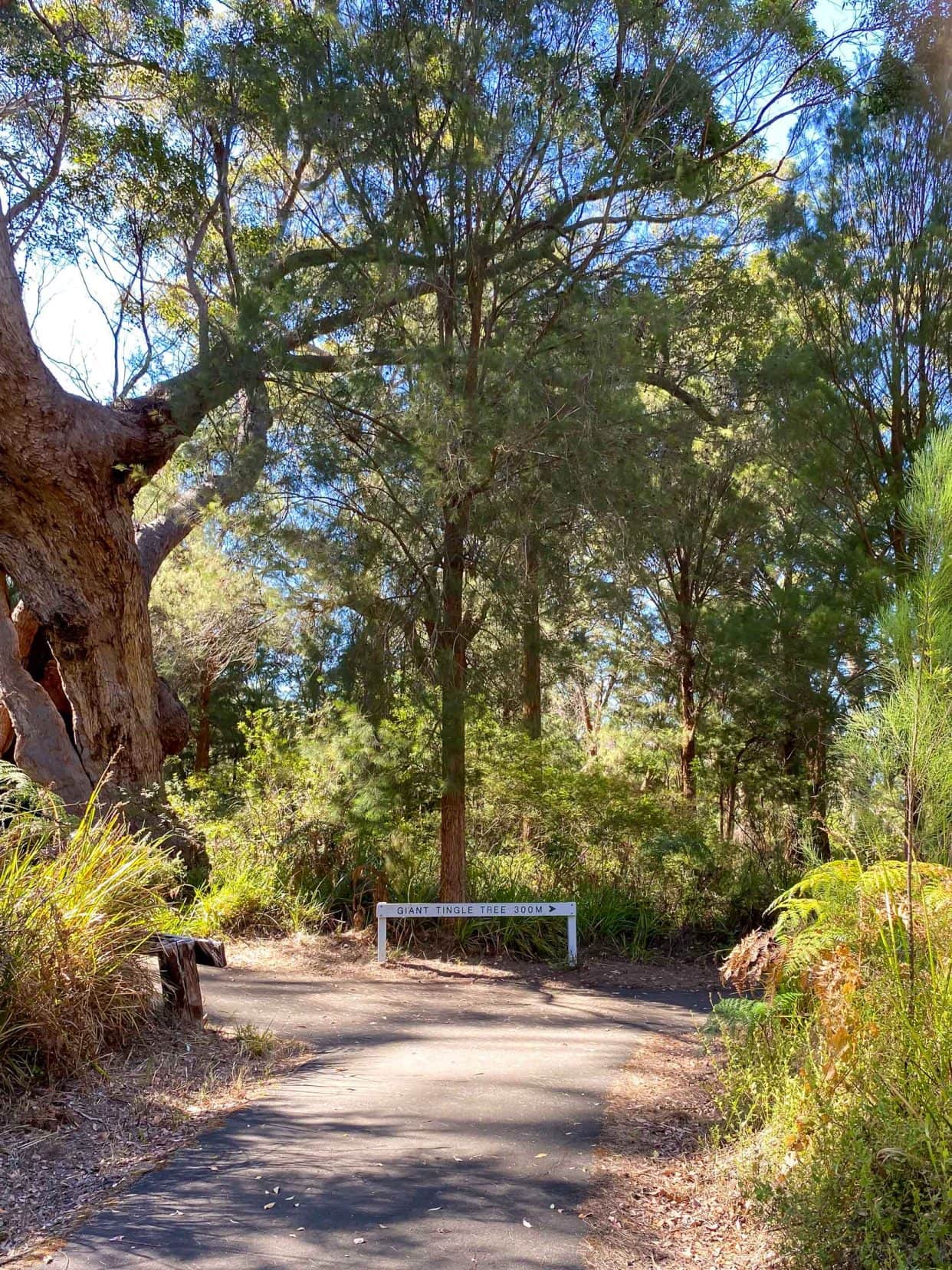
Our Experience on the Giant Tingle Loop
Time on The Giant Tingle Loop
Our visit to the loop was meant to be a leisurely exploration. We aimed to spend well over half an hour among these ancient giants. However, the relentless march flies had other plans, significantly shortening our stay.
Finding a bench along the path, I hoped to blend enough for the red-winged fairy-wrens to venture close. Their playful dance through the undergrowth was captivating, a peaceful contrast to the persistent flies.
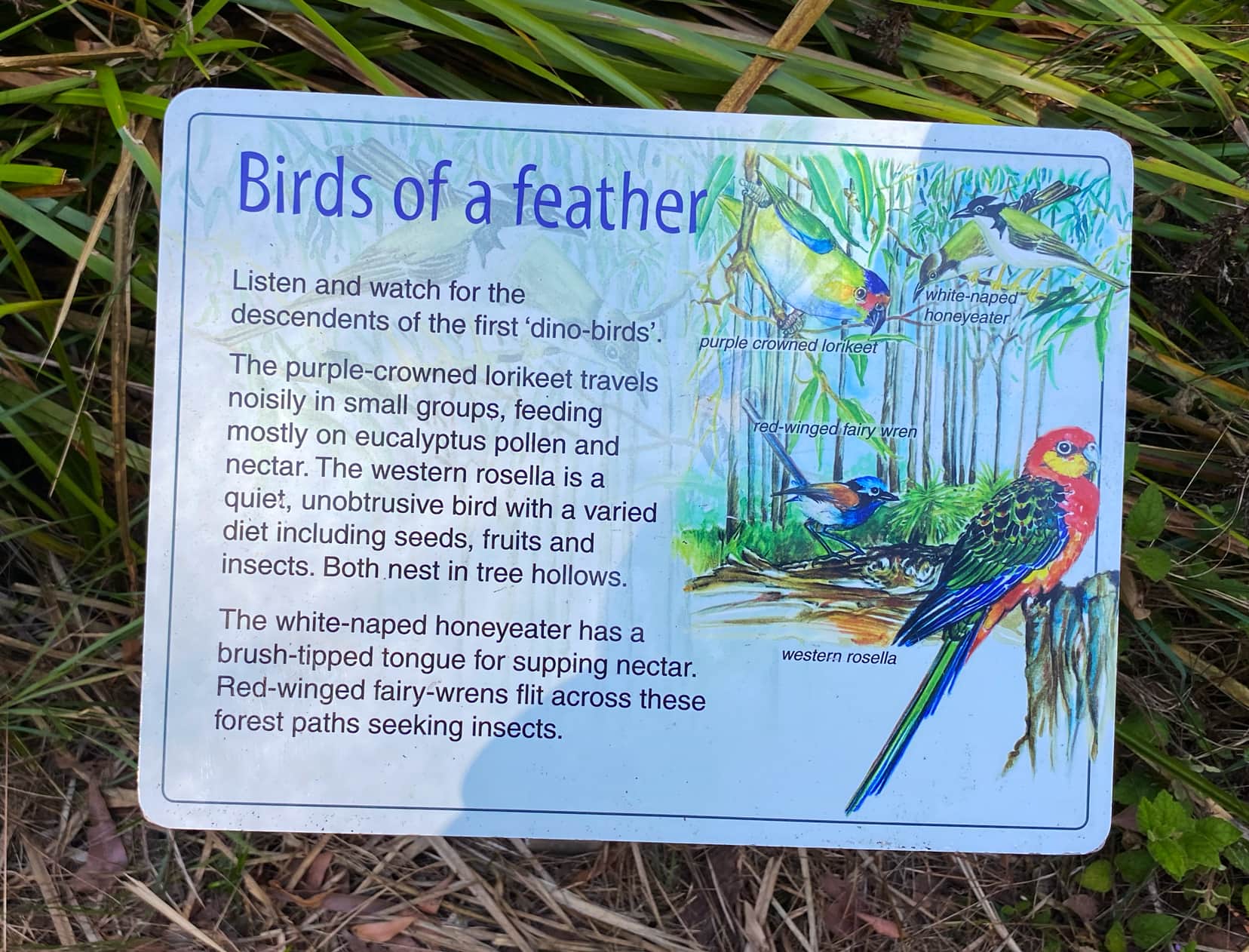
However, sitting quietly here was an invitation for the march flies. Despite my best efforts, armed with long pants and fly spray, these persistent critters made it clear they were in charge.
Trying to soak in the tranquillity of the forest while being buzzed and bitten was a challenge, to say the least. It turned my hoped-for quiet contemplation into a battle.
Nature sometimes has its own ideas about how we experience its wonders.
The Pathway
The pathway is an educational journey lined with colourful plaques detailing the flora and fauna you might encounter.
Flanked by an array of tingle and karri trees, the trail is also home to the distinctive understory plants unique to this ecosystem, such as sword grass and tassel flower (Leucopogon verticillatus), which stand out with their natural beauty.
As an interesting aside, we learned that these very plants, the sword grass and tassel flower, inspired the design of the nearby Valley of the Giants Tree Top Walk — a testament to the inspirational power of nature.
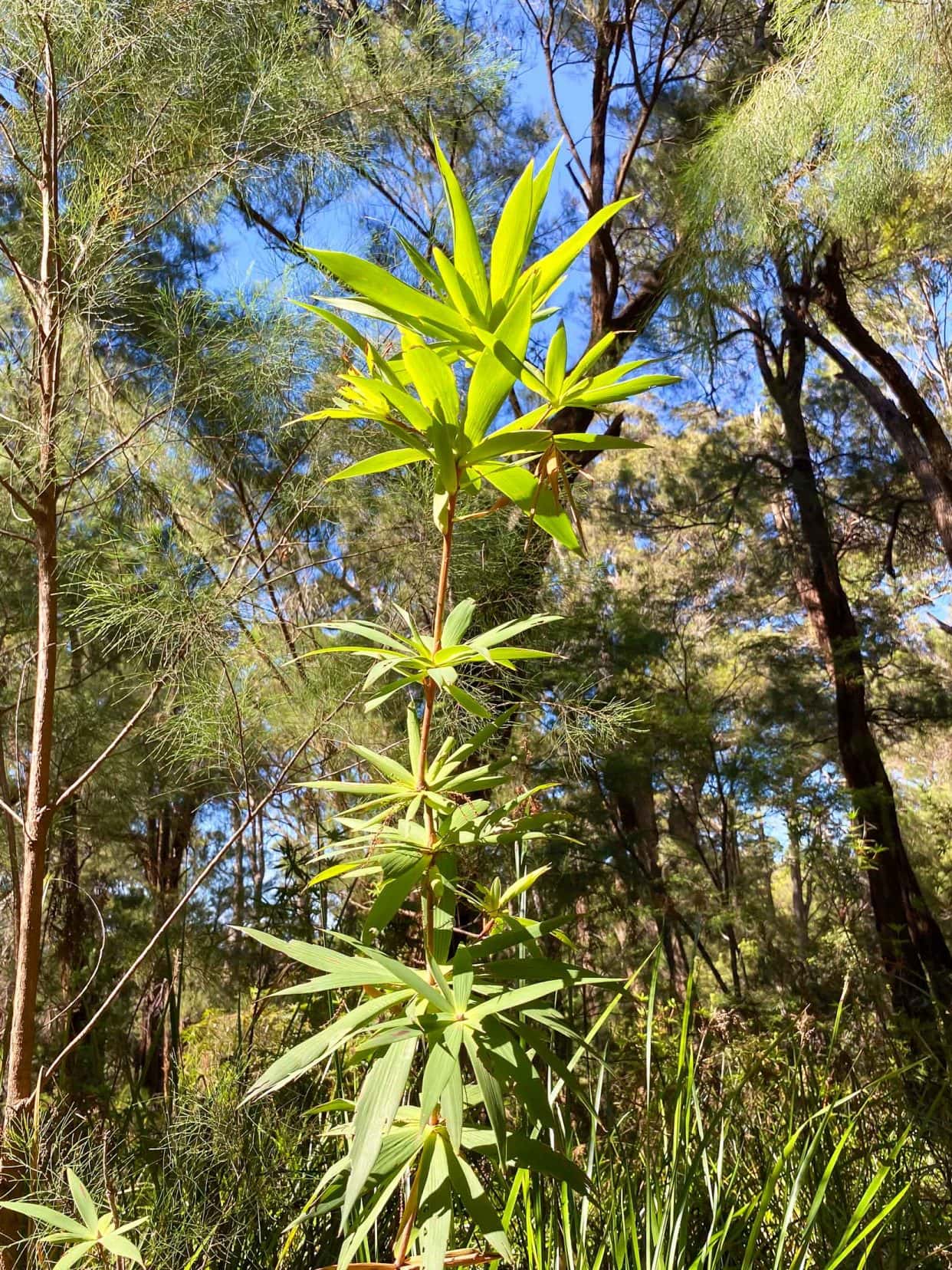
Giant Tree Boardwalk
Nearer to the tree, you’ll see that the path leads onto a boardwalk, which protects the delicate tingle root system. You can stand inside this 300-year-old tree and appreciate this wonder of nature, which has stood the test of time.
Standing on the boardwalk, designed to safeguard the tree’s roots, offered comfort in knowing we could admire this giant up close without harming it — a lesson learned from its predecessor’s fate.
The remains of the previous giant tingle are now in the ancient forest in the Valley of the Giants. This fallen behemoth was once a massive drawcard for tourists who hankered after a photo with their car parked in the tree.
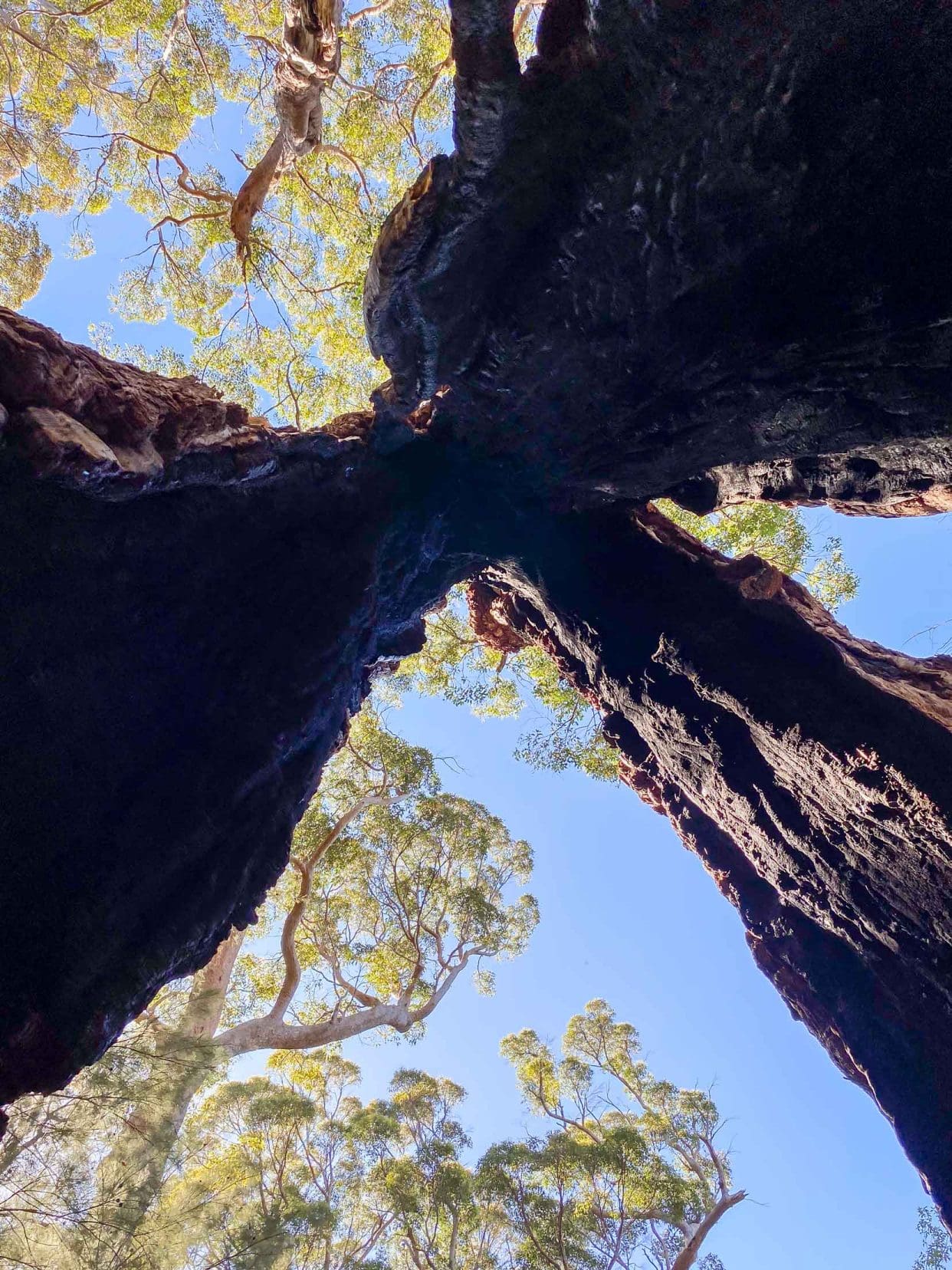
Unfortunately, the delicate roots were impacted, and the tree finally collapsed in 1990. This was a pivotal moment in the decision to protect the tingle trees and develop an area around them that was still accessible for the public to enjoy.
Hence, the Valley of the Giants Tree Top Walk was designed and opened to tourists in 1996.
Reflecting on the visit, it’s clear that the Giant Tingle Tree Loop offers more than just a walk; it’s a journey through time and a reminder of our responsibility to protect these natural wonders for future generations.
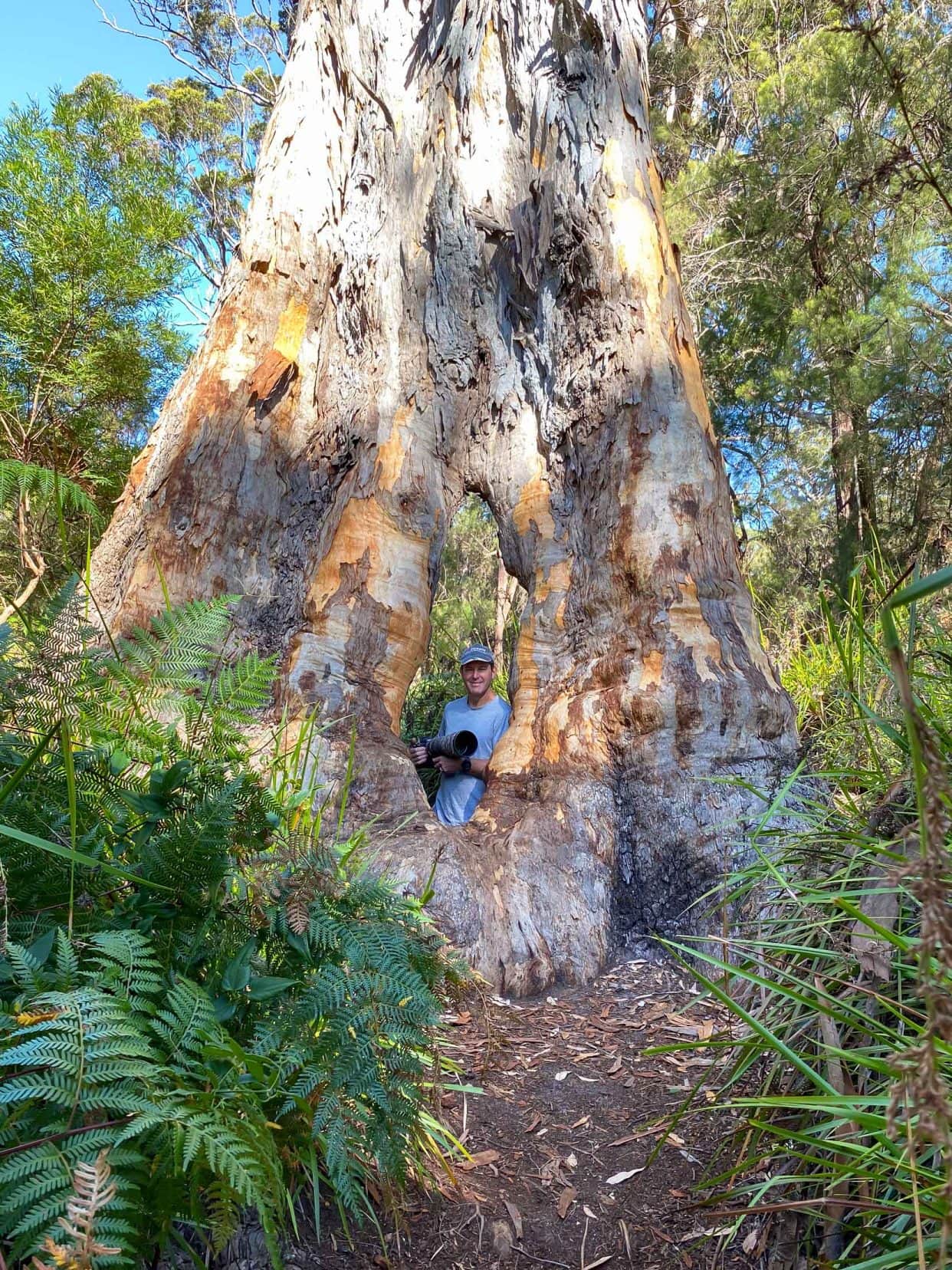
Capturing the Giant: Photography Tips
Photographing the Giant Tingle Tree in Walpole offers a unique opportunity to capture one of Australia’s most majestic natural wonders.
As an expert photographer, Lars has a few tips to help you bring home images that do justice to this colossal tree’s beauty.
Best Time for Lighting
- Golden Hours: Aim for the golden hours, just after sunrise or before sunset. The softer light accentuates the tree’s textures and colours and minimises harsh light.
- Overcast Days: Cloudy days can also be ideal, providing diffused light that evenly illuminates the tree’s massive girth and intricate details.
Recommended Equipment
- Wide-Angle Lens: Essential for capturing the full majesty of the tree and its surroundings. A wide-angle lens allows you to photograph the entire tree, even from a close distance.
- Tripod: A tripod is crucial for stability, especially in low light conditions during the golden hours or overcast days. It also allows for longer exposures if you’re capturing the surrounding forest or sky.
- Polarising Filter: This helps to reduce glare from the tree’s leaves and can make the sky pop, providing a more vibrant backdrop.
- Macro Lens (Optional): For capturing detailed shots of the bark, leaves, or unique features at the tree’s base.
Creative Angles and Compositions
- Look Up: Position yourself at the tree’s base and shoot upwards. This perspective emphasises the tree’s height and the canopy’s expanse.
- Use the Path: Incorporate the circular walk’s pathway leading to the tree in your composition for a sense of depth and journey.
- Framing: Use the surrounding forest to frame the Giant Tingle Tree, highlighting its stature among the ancient woodland.
- Inside the Hollow: If possible, capture the interior of the hollowed trunk, using the contrast between the dark interior and the light filtering in from above.
- Storytelling: Include elements that tell a story, like a person for scale or the delicate ecosystem at the tree’s base, to convey its significance and the conservation efforts surrounding it.
Post-Processing Tips
- Enhance Details: Slightly increase clarity and texture in your editing software to reveal the details of the bark and leaves.
- Adjust White Balance: Ensure the greens and browns of the forest are true to what you saw, enhancing the natural beauty without oversaturating.
Photographing the Giant Tingle Tree is a privilege that comes with responsibility. Always respect the environment, staying on designated paths to protect the tree and its habitat.
With these tips, you’re ready to capture the essence of this towering giant, creating images that reflect its awe-inspiring presence and the story of its ancient home.
We visited in summer, and as mentioned, the March flies were out in force, which didn’t put us in the mood to stay. The best time to enjoy your photography here would be in the cooler months.
A Sustainable Visit: Protecting Walpole’s Natural Beauty
Staying on designated paths is crucial. The tingle trees’ unique buttress root system, which spreads outward rather than downward, makes them especially vulnerable to foot traffic. This adaptation aids their survival against fires and internal hollowing, underscoring the importance of minimizing our impact by adhering to established trails.
Please use the facilities near the car park to help keep our natural spaces pristine. Seeing toilet paper littering the bush diminishes the natural beauty we’re here to enjoy. All visitors must contribute to preserving the environment’s cleanliness.
A quick refresher on bush drop toilet etiquette can significantly improve the experience for all visitors. Familiarizing yourself with the dos and don’ts ensures that our collective presence is as unobtrusive as possible, allowing everyone to enjoy the untouched beauty of Walpole’s wilderness.

Planning Your Visit
The Giant Tingle Tree, nestled within Walpole-Nornalup National Park, attracts visitors year-round. Expect it to be busiest during Public Holidays and school vacations, as it’s a favoured destination for many.
While the tree and its surrounding forest welcome visitors throughout the year, the spring months of September and October offer a unique spectacle with wildflowers blooming beneath the towering giants.
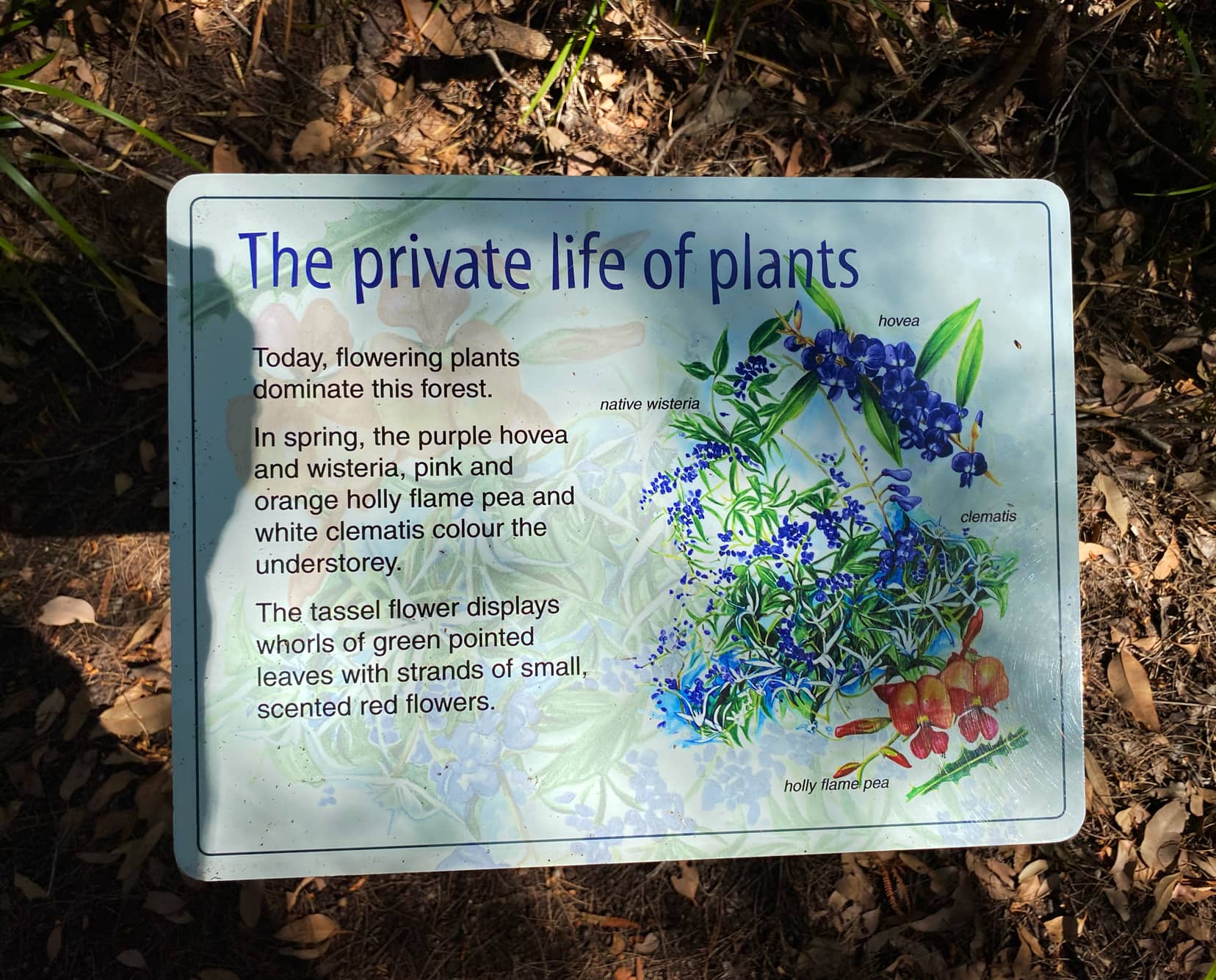
This season not only enhances the beauty of the landscape but also provides an enjoyable experience for those wandering through the ancient forest.
Adult March flies are most active in daylight during the warmer months, particularly on calm, sunny days. So also bear this in mind when planning your visit.
Walpole and Surrounds: Navigating Walpole’s Natural Wonders
Exploring Walpole offers an array of natural wonders and unique experiences, each adding layers to the story of this remarkable region.
Here’s a list of some we’ve visited and recommend:
Valley of the Giants Ancient Empire Walk and Tree Top Walk
Start with these iconic attractions to better understand the ancient tingle trees. The Tree Top Walk, in particular, offers an unforgettable view from 40 meters above, perfectly introducing the grandeur of Walpole’s ancient forests.
Circular Pool
A short 7 km drive from the Giant Tingle Tree, this serene natural pool is a peaceful haven, ideal for quiet reflection and a must-visit spot for those exploring the area.
Coalmine Beach Heritage Trail
This 6km trail from Coalmine Beach to the town, including the Visitor Centre, is not just a walk through history but also an opportunity to see a ‘shaka’ of quokkas (the collective noun for a group of quokkas) in their natural setting, adding a unique wildlife encounter to your visit.
Swarbrick Art Loop
Merging art with nature, this trail offers thought-provoking installations amidst the wilderness, inviting visitors to see the natural world through a creative lens.
WOW Wilderness Eco Cruise
This is truly one of the best activities for visitors to Walpole. The WOW eco-cruise, which we’ve personally experienced, is a real stand-out.
Led by a guide who’s passionate and knowledgeable about the local ecosystem and has a great sense of humour, the tour offers an insightful and entertaining exploration of Walpole’s waterways.
This cruise will be a highlight of any visit to Walpole. It engages and memorably showcases the area’s beauty and ecological diversity.
Each of these attractions contributes to a full and enriching experience of Walpole, from the heights of the ancient canopy to the tranquil waters of the inlets and the artistic interpretations of the forest’s beauty.
Conspicuous Cliff, Walpole
Conspicuous Cliff offers a breathtaking blend of rugged coastline and serene beach vistas within Walpole-Nornalup National Park.
Its easy accessibility makes it a standout destination for those seeking the beauty of Western Australia’s southern coast without the crowds.
The journey down its wooden boardwalk reveals stunning ocean views, culminating in a picturesque beach perfect for quiet contemplation and enjoying nature’s untouched beauty.
Finding Your Perfect Stay in Walpole
Walpole offers a variety of accommodation options, each with its unique charm, ensuring every traveller finds their perfect match. From cozy caravan parks in nature to luxurious chalets by the river, Walpole caters to all preferences and budgets.
Coalmine Beach Caravan Park- A Gateway to Nature
Our top pick, Coalmine Beach Caravan Park, is an exceptional choice for visitors. Here’s why it’s our favourite:
- Wildlife Encounters: As part of the National Park, where pets aren’t allowed, the park becomes a wildlife sanctuary. It’s not uncommon to have friendly encounters with the local wildlife, such as kangaroos, right at your campsite, making for unforgettable mornings and evenings.
- Prime Location: Situated right on the picturesque Nornalup Inlet and just a stone’s throw from Coalmine Beach, the park offers direct access to tranquil waters and sandy shores. A leisurely 3km walk along the Heritage Trail connects you to Walpole town, while the nearby Knoll Scenic Drive offers breathtaking walks, lookout points, and picnic areas.
- Top-Notch Facilities: The park boasts a prime location and is equipped with excellent facilities to ensure a comfortable stay, whether you opt for a powered or unpowered campsite, a chalet, or a luxury tent.
With a rooftop tent on our car, we’ve enjoyed both powered and unpowered sites here, but the chalets and luxury tents are also fantastic options, boasting a Booking.com score of 9/10.
The ambience, combined with the accessibility to nature and wildlife, makes it a standout experience.
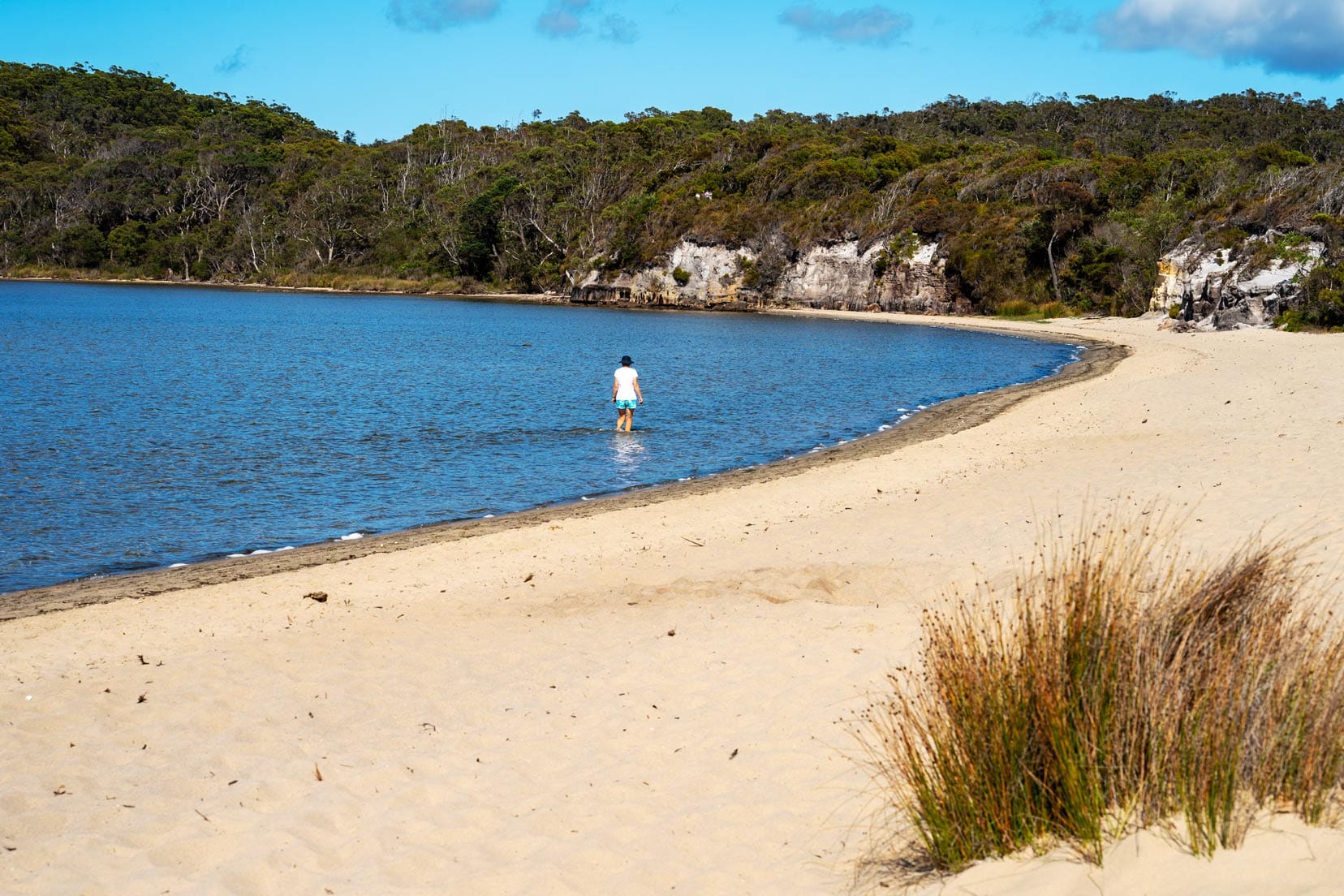
Other Places to Stay in Walpole
Other options nearby include:
- Tinglewood Cabins | ⭐️ 9.2/10 | North Walpole | Private parking | Kitchenette | Find out more or book
- Che Sara Sara Chalets | ⭐️ 8.9 /10 | 15km NE Walpole | on the banks of the Frankland River | Find out more or book here
- Tree Top Walk Motel | ⭐️ 7.6 /10 | In centre Walpole | 4-star motel | Find out more or book here
Planning Ahead
Given the popularity of these spots, especially during peak seasons like school holidays and public vacations, we highly recommend checking availability and booking early to secure your ideal accommodation.
Whether you’re interested in the immersive natural experience of Coalmine Beach Caravan Park or the serene river views at Che Sara Sara Chalets, planning ensures you won’t miss out on the best Walpole has to offer.
FAQs
How Old is the Giant Tingle Tree?
The Giant Tingle Tree in Walpole is estimated to be over 300 years old, making it a living testament to the ancient landscape of the Walpole-Nornalup National Park. Its longevity highlights the resilience and enduring nature of these remarkable trees.
Where Do Red Tingle Trees Grow?
Red tingle trees (Eucalyptus jacksonii) are native and only found in the southwestern region of Western Australia in the Walpole Wilderness area. They thrive in the Walpole-Nornalup area, within the cool, damp conditions of the region’s temperate rainforests, making this location unique for their growth.
How Do You Get to the Giant Tingle Tree?
To visit the Giant Tingle Tree, travel to Walpole-Nornalup National Park, located near Walpole in Western Australia. Take the South Coast Highway from Walpole, then turn onto Hilltop Road, which leads directly to the site. The area is well-signposted, making the tree accessible for visitors.
How Big Are the Giant Tingle Trees?
Giant Tingle Trees can reach impressive sizes, with heights up to 75 meters and a base circumference exceeding 20 meters. They are known for having one of the most enormous girths of any eucalypt, making them among the most colossal trees in the world.
Why are they called Tingle Trees?
According to the Valley of the Giants Tree Top Walk website, “Tingle” is believed to be derived from the Aboriginal word ‘dingul’. This term reflects the indigenous heritage and deep connection to the land where these remarkable trees grow.
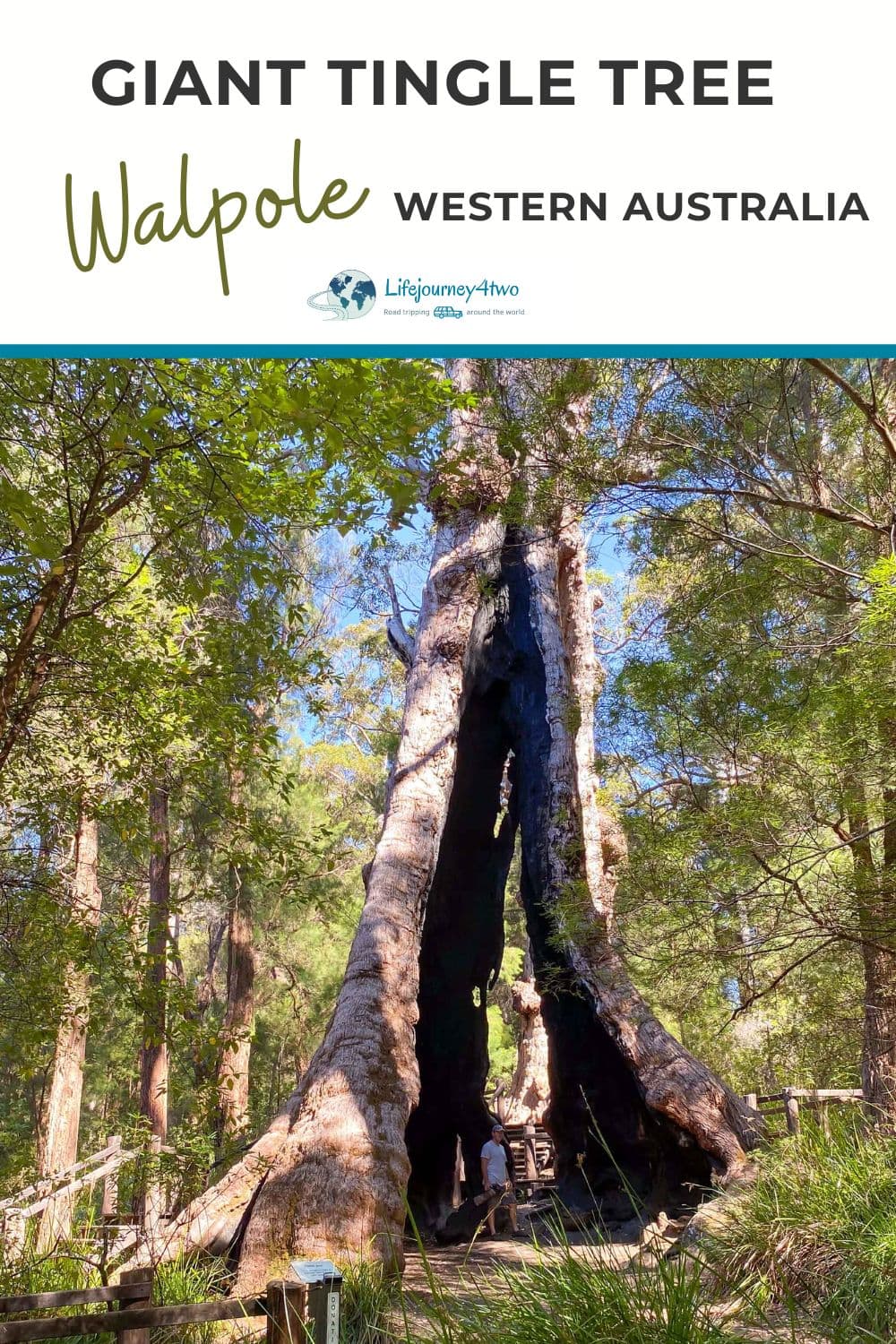
Walpole’s Giant Tingle Tree … That’s a Wrap
Our walk to the Giant Tingle Tree and through the 1km loop has been worth every step. It’s shown us nature’s sheer scale and beauty in Walpole.
This visit wasn’t just about seeing a tree, but understanding the importance of preserving these natural wonders.
Standing next to the Giant Tingle has been a highlight, a real testament to nature’s power and resilience.
We leave this place more aware and appreciative of the natural world. If you’ve read this far, maybe you’re considering a visit too. Trust us; it’s an experience you will want to experience.
Unlike the often-busy Valley of the Giants Ancient Empire Walk, our visit to the Giant Tingle Tree felt more personal and intimate, thanks to having fewer visitors. It’s a serene escape that complements any trip to Walpole, offering a unique moment of quiet connection with nature.
And let’s not forget the March flies — ever eager to be part of your experience, they compete fiercely for your attention. In Walpole, even the wildlife wants in on the action! Here’s hoping they give you more peace than they gave us.
Acknowledgement of Country
In every adventure we embark upon and every landscape we cherish, it’s crucial to recognize the original custodians of these lands.
We extend our respects to the Menang People, the traditional landowners of Walpole-Nornalup National Park.
Their enduring connection to the country, rich cultural heritage, and practices are fundamental to preserving and understanding this magnificent natural area.
We stand in solidarity and respect for their Elders past, present, and emerging, and acknowledge their stewardship of these lands throughout generations.
PLANNING YOUR TRAVELS?
These are the travel resources we recommend and use when planning our trips.
- 🚘 Car Hire: We use DiscoverCars.com
- Motorhome/Campervan Rental: We highly recommend the Motorhome Republic
- 🛏 Book Accommodation: We use Booking.com to find accommodation that suits our budget
- 🐶 Pet Sitting/Pet Sitters: Check Out TrustedHousesitters here (Use our Discount code: LIFEJOURNEY25 for 25% off. )
- Activities and Experiences: Get Your Guide and Viator
- Travel Insurance: Safetywing or World Nomads
- 🥾 Travel Gear and Accessories: Check out our top picks here — Lifejourney4two page on Amazon
For a more thorough list visit our Travel Resources page here.

